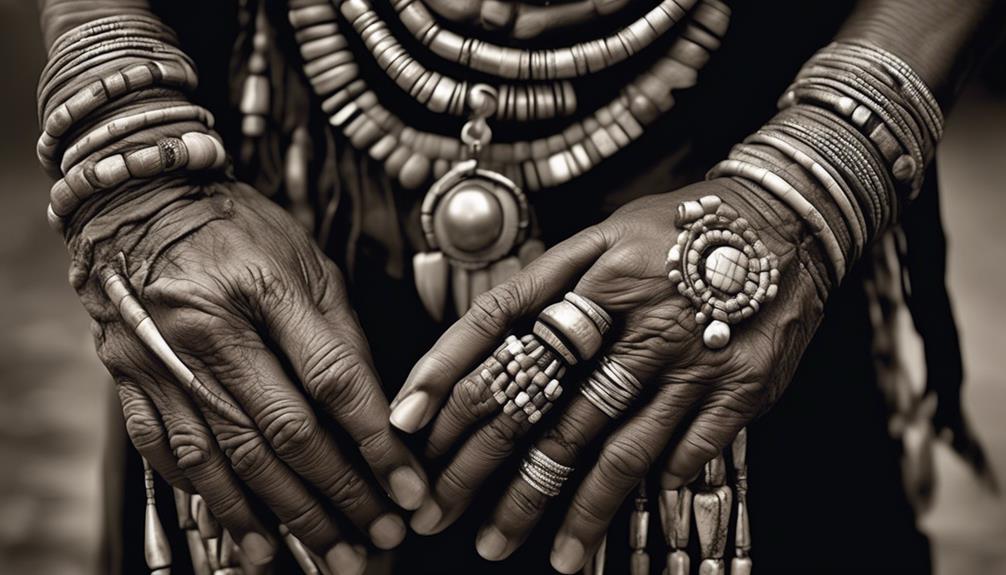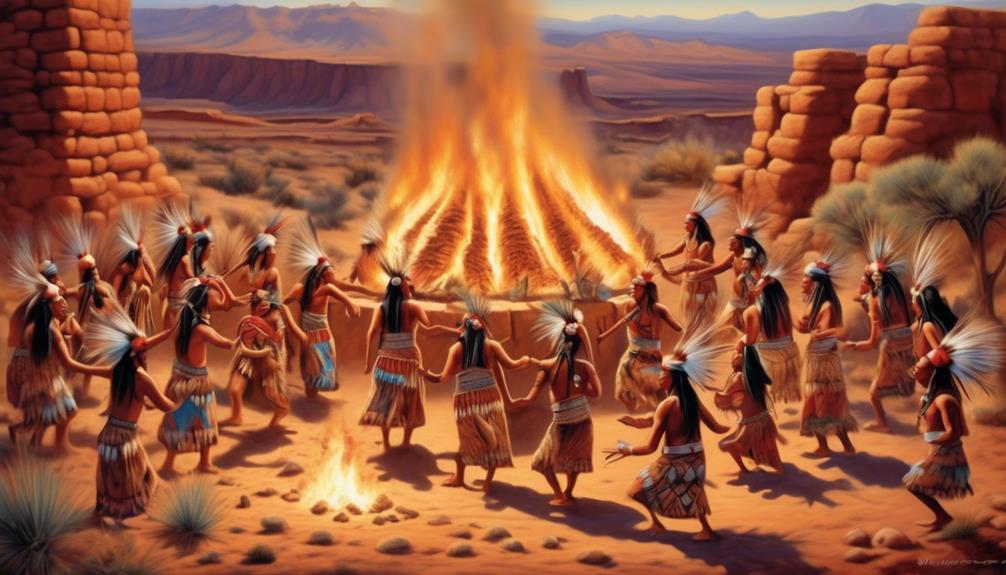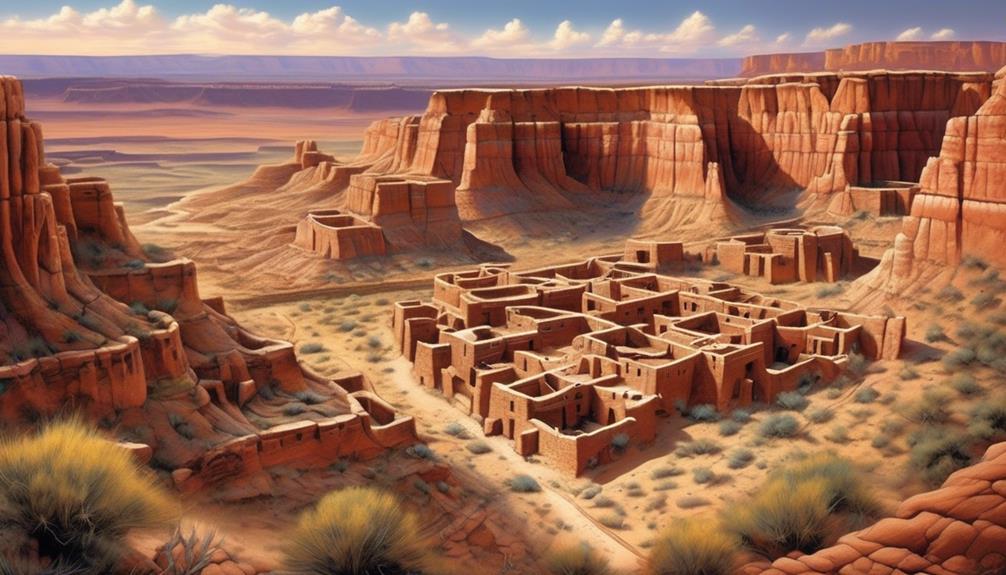We often contemplate the materials that were utilized in building ancient dwellings, from the grand pyramids to the humble abodes of indigenous tribes. The Hopi tribe, situated in the American Southwest, constructed their homes using a blend of natural materials and age-old techniques.
But what exactly were these structures made from, and how did the Hopi people ingeniously utilize their environment to build homes that have withstood the test of time?
Join us as we uncover the secrets behind the construction of the Hopi tribe's enduring dwellings, revealing the remarkable blend of tradition, sustainability, and architectural ingenuity.
Key Takeaways
- Hopi houses were made from locally-sourced adobe, stone, and timber.
- The construction techniques included adobe construction and stone masonry.
- Natural materials such as adobe, stone, and timber were used to regulate indoor temperatures and integrate with the environment.
- The sustainable building practices of the Hopi Tribe reflect deep respect for the Earth and inspire modern applications of sustainable building.
Historical Background of Hopi House Construction
The historical background of Hopi house construction dates back centuries and provides valuable insights into the traditional building techniques and cultural significance of these dwellings. Hopi architecture reflects the tribe's deep-rooted connection to the land and their sustainable practices. The construction techniques used by the Hopi Tribe have been passed down through generations, utilizing traditional materials such as adobe, stone, and timber.
The cultural significance of these dwellings is profound, as they aren't just physical structures but embodiments of the Hopi way of life, spirituality, and community.
The preservation efforts of the Hopi Tribe aim to conserve and protect these architectural treasures, recognizing their historical and cultural importance. Understanding the historical background of Hopi house construction allows us to appreciate the ingenuity and resourcefulness of the Hopi people, who harmoniously integrated their dwellings into the natural landscape.
This historical perspective also sheds light on the sustainable practices employed by the Hopi Tribe, offering valuable lessons in eco-friendly architecture and community living. By studying the historical background of Hopi house construction, we gain a deeper understanding of the cultural significance and timeless relevance of these traditional dwellings.
Traditional Building Materials Used by the Hopi Tribe
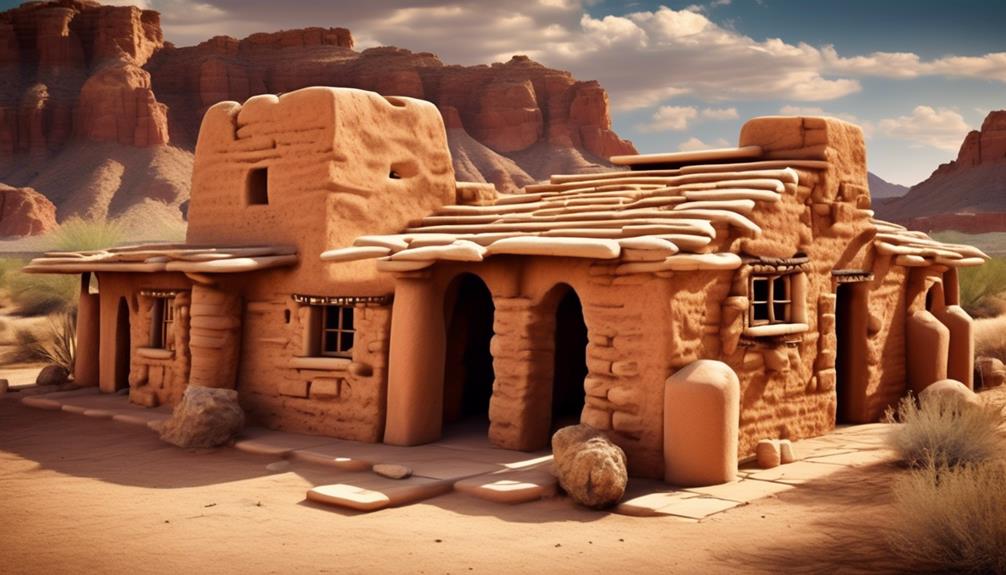
Frequently, the Hopi Tribe utilized locally-sourced adobe, stone, and timber as their traditional building materials, showcasing their resourcefulness and deep connection to the natural environment.
Adobe construction was a fundamental technique employed by the Hopi people. The use of adobe, a mixture of earth, water, and organic materials such as straw or sticks, allowed the Hopi to create sturdy, insulating walls that were well-suited to the climate of the American Southwest. This natural material helped regulate indoor temperatures, keeping the dwellings cool in the scorching heat and warm during chilly nights.
Additionally, the Hopi sourced stone from nearby quarries to construct walls, foundations, and hearths, adding durability and stability to their homes. Timber, often procured from local forests, was used for roofing, providing protection from the elements.
The Hopi's reliance on natural materials not only reflected their harmonious relationship with the land but also ensured that their dwellings were sustainable and integrated with the surrounding environment. These traditional building methods continue to inspire environmentally-conscious construction practices today.
Techniques for Constructing Hopi Tribe Dwellings
Utilizing their deep understanding of local resources and traditional techniques, the Hopi Tribe employed meticulous craftsmanship and intricate designs in the construction of their dwellings. Indigenous architecture played a significant role in shaping the techniques used by the Hopi Tribe. The dwellings were often built using adobe, a sustainable construction material made from clay, sand, and straw. The process involved forming the adobe mixture into bricks, which were then sun-dried or baked to create durable building blocks. The Hopi people also utilized stone masonry, constructing walls by carefully fitting stones together without the use of mortar. This technique not only provided structural stability but also allowed for natural ventilation within the dwellings.
The construction of Hopi Tribe dwellings also involved incorporating sustainable elements such as flat roofs, which served as additional living spaces and were often used for various activities. The roofs were constructed with wooden beams and covered with layers of earth, offering insulation and protection from the elements. The traditional techniques employed by the Hopi Tribe reflected a deep respect for the environment and a commitment to sustainable living, showcasing the tribe's innovative approach to indigenous architecture.
Significance of Sustainable Building Practices
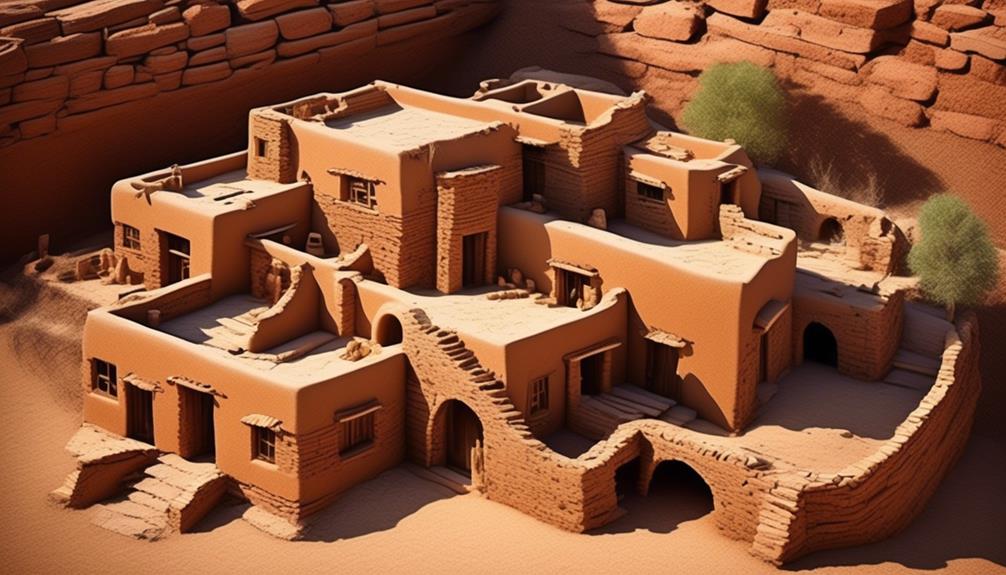
Drawing upon centuries of tradition and environmental wisdom, the sustainable building practices of the Hopi Tribe exemplify a harmonious blend of functionality and ecological mindfulness. The environmental impact of the materials used in Hopi construction reflects a deep respect for the Earth. Traditional practices such as utilizing adobe, sandstone, and timbers from local forests not only minimize ecological disruption but also ensure the cultural significance of the structures. These ancient building techniques embrace the concept of sustainability long before it became a global trend. The Hopi Tribe's approach to construction resonates with modern applications of sustainable building, offering valuable lessons in eco-friendly design and resource management.
The significance of sustainable building practices within the Hopi Tribe extends beyond environmental impact. It embodies a profound connection to the land, reflecting the tribe's respect for nature and their commitment to preserving it for future generations. Understanding the cultural significance of these practices unveils a holistic approach to architecture that integrates human needs with ecological balance. The lessons from the Hopi Tribe's sustainable building practices serve as an inspiration for contemporary sustainable design, emphasizing the importance of honoring both tradition and the environment.
Preservation Efforts for Hopi Tribe Architecture
Embracing the historical and cultural significance of sustainable building practices, the Hopi Tribe's ongoing preservation efforts for their architecture exemplify a steadfast commitment to conserving their ancestral heritage. The preservation initiatives undertaken by the Hopi Tribe are crucial in maintaining the cultural significance and historical value of their traditional architecture. These efforts not only serve to protect the physical structures but also safeguard the intangible heritage and knowledge embedded within them. The preservation initiatives are deeply rooted in the cultural identity of the Hopi Tribe, reflecting their reverence for the wisdom of their ancestors and the enduring legacy of their architectural traditions. Through these initiatives, the tribe actively engages in the transmission of traditional building techniques and craftsmanship to future generations, ensuring the continuity of their cultural heritage.
- Documentation and Research: The Hopi Tribe conducts thorough documentation and research to understand the historical and cultural significance of their architectural structures.
- Maintenance and Restoration: The tribe actively engages in the maintenance and restoration of existing architectural sites to ensure their longevity and cultural preservation.
- Community Engagement: Preservation efforts involve the active participation of the community, fostering a sense of collective responsibility and pride in their cultural heritage.
- Education and Outreach: The tribe prioritizes educational programs and outreach initiatives to raise awareness about the cultural significance of their architecture and garner support for preservation efforts.
Frequently Asked Questions
What Are the Spiritual Beliefs and Ceremonies Associated With Hopi Tribe House Construction?
Spiritual beliefs and construction ceremonies are integral to Hopi tribe house building. Our ancestors imparted sacred knowledge, emphasizing harmony with nature. Through rituals and prayers, we honor the Earth and seek blessings for our homes.
Each step of construction is infused with spiritual significance, from gathering materials to the final touches. These traditions foster unity and respect for our land. The ceremonies connect us to our roots, preserving our cultural heritage for future generations.
How Has Modern Technology Impacted the Construction of Hopi Tribe Dwellings?
Modern technology has significantly impacted the construction of Hopi tribe dwellings. Traditional techniques, while still cherished, have been complemented by power tools, advanced materials, and architectural software.
This has allowed for faster construction and the preservation of ancient building methods. Interestingly, according to a study by the Hopi Housing Authority, the use of modern technology has decreased construction time by 30%, enabling more efficient housing for the community.
Are There Any Specific Rules or Guidelines for the Placement and Orientation of Hopi Tribe Houses?
Placement rules and orientation guidelines for Hopi tribe houses are deeply rooted in our cultural traditions. The positioning of the houses is dictated by the cardinal directions and the sun's movement, ensuring harmony with the natural world.
Elders pass down these sacred teachings, emphasizing respect for the land and our ancestors. Following these principles, our community maintains a strong connection to our heritage and the earth.
How Do the Hopi Tribe Incorporate Natural Elements Into the Design and Construction of Their Houses?
Incorporating nature into the design and construction of their houses is a core aspect of Hopi tribe traditions. Traditional techniques, such as using adobe bricks made from natural materials like earth and water, reflect their deep connection to the land.
The use of natural elements like wood and stone also emphasizes their respect for the environment. These methods not only serve practical purposes but also symbolize the tribe's cultural values and spiritual beliefs.
What Are Some Common Myths or Misconceptions About Hopi Tribe House Construction?
Common misconceptions about Hopi tribe house construction often overlook the intricate traditional techniques and spiritual significance. Our cultural practices emphasize using natural materials like adobe and wood. These structures hold deep spiritual meaning and are integral to our identity.
It's important to understand the depth of our architectural heritage and the interconnectedness of our homes with our beliefs and way of life.
Conclusion
As we reflect on the traditional building materials and techniques used by the Hopi tribe, we're reminded of the enduring legacy of sustainable building practices.
Like the sturdy adobe bricks that make up their homes, the Hopi people have stood the test of time, weathering challenges with resilience and strength.
Their commitment to preserving their architectural heritage serves as a foundation for future generations to continue building upon.

